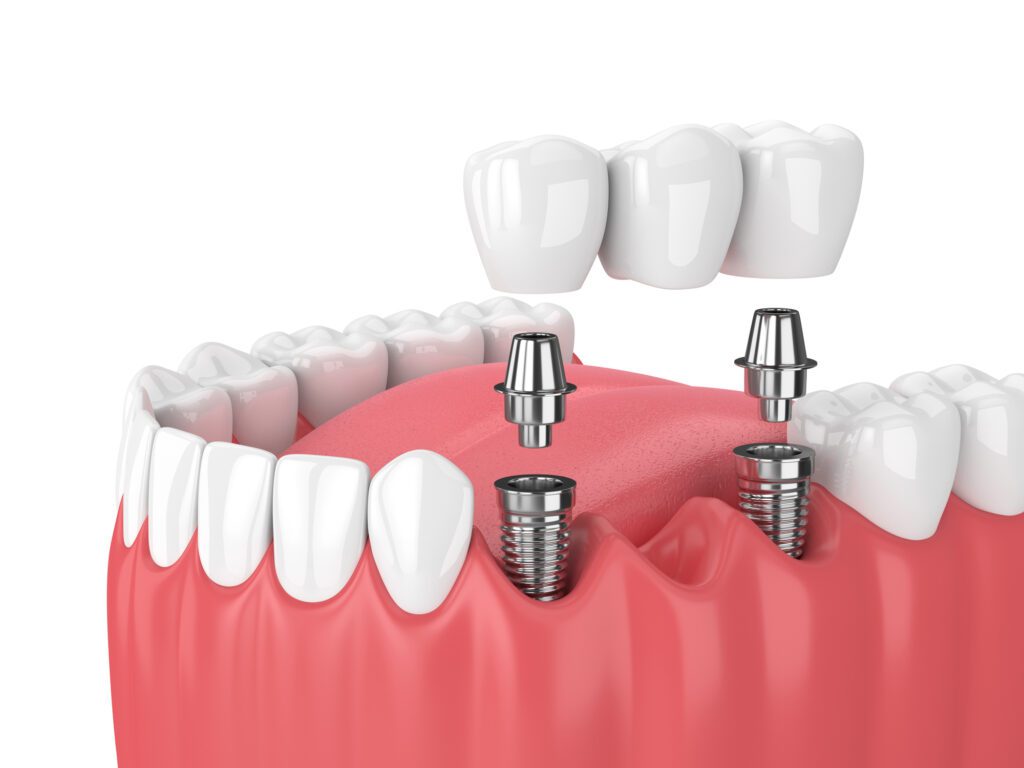Dental implants are medical tools that Dr. Michael Courter uses to replace missing teeth. This intricate dental device can replace one, several, or an entire arch of teeth. Dr. Courter offers dental implants in Midland, TX, for patients who want the most natural tooth replacement option. Here, we will review the parts of a dental implant and the types of implant restorations we provide in Midland, TX.

The Parts of a Dental Implant Restoration
A dental implant restoration comprises several components, each serving a specific purpose in restoring a patient’s smile. A typical dental implant restoration comprises three parts: the implant post, the abutment, and a dental restoration. Before choosing this option, Dr. Courter wants his patients to understand how each component of an implant restoration works.
Implant Fixture: The Foundation of a Dental Implant Restoration
The implant fixture is the anchor of the dental implant restoration, serving as an artificial tooth root. Typically made of biocompatible materials such as titanium, implant fixtures provide stability and durability. The fixture is essentially a post that resembles a screw with threads.
To secure it, you must undergo a surgical procedure where the implant post will be inserted into the jawbone. Here, it will fuse to the bone.
Implant Fixture Sizes
Implant posts come in various sizes to accommodate different patient’s needs. There are three basic sizes: standard, mini, and wide. The length can range from 8 mm to 16 mm. However, the diameter is based on the patient’s needs, where the implant is placed, and available bone mass. The diameters of the three basic sizes of implants are:
- Standard Dental Implant: 3.5 mm – 4.3 mm
- Mini Dental Implant: 2 mm – 3.5 mm
- Wide Dental Implant: 4.5 mm – 6mm
In most cases, Dr. Courter will use a standard implant. It is necessary to use a mini implant when there is little space between the teeth roots or with patients who lack bone mass. A wide implant is necessary when patients replace larger teeth with more expansive root systems, such as the teeth in the back of the mouth. Dr. Courter will determine the exact position of the dental implants based on your oral health, bone density, and the specific tooth being replaced.
Abutments: Connecting Implant Fixtures to Restorations
We place abutments, or connectors, on the implant fixtures that support dental restorations. They come in various materials, including titanium, zirconia, and stainless steel. There are many types of abutments available.
The type of abutment you will need depends on several factors. Your oral anatomy, the aesthetics you are going for, and the implant position. A custom abutment is typically preferred for irregular shapes, better aesthetic results, and implants in challenging locations within the mouth.
Types of Dental Implant Abutments
There are several types of abutments that we can use in our office:
- Stock Abutments: These abutments are pre-made and come in various shapes and sizes. Stock abutments are suitable for standard cases. These are the most commonly used types of abutments for the majority of implant cases.
- Custom Abutments: We can create a custom abutment tailored to your oral anatomy. These are ideal for complex cases where precise fit is crucial.
- Temporary Abutments: In some cases, a temporary abutment is necessary. We use them during the healing period after implant placement, providing aesthetic and functional benefits.
Dental Restorations: Completing the Implant with Prosthetic Teeth
A dental restoration is the visible part of the dental implant, providing natural-looking teeth. Dr. Courter offers different restorations to accommodate his patient’s unique needs and preferences. The type of dental restoration you will need depends on how many teeth you are missing, where they are located, the state of your oral health, and your budget.
Types of Dental Restorations
Our office provides multiple restorations that use implants:
- Single Crowns: We use dental crowns to replace a missing tooth. A crown acts like a tooth cap to cover an implant like a natural tooth fully.
- Dental Bridges: A bridge is suitable for replacing multiple adjacent missing teeth, using implants as support. Bridges consist of multiple false teeth in a row.
- Dentures: Implant-supported dentures replace an entire arch of teeth or most of the teeth on an arch. Dental implants can support false teeth in different mouth areas or full prosthetics.
Call For Restorative Dental Treatment Today
Understanding the parts of dental implants is important if you are considering replacing your teeth. Schedule a consultation with Dr. Courter to learn more about dental implants in Midland, TX. Call 432-287-9531 or request an appointment online.
